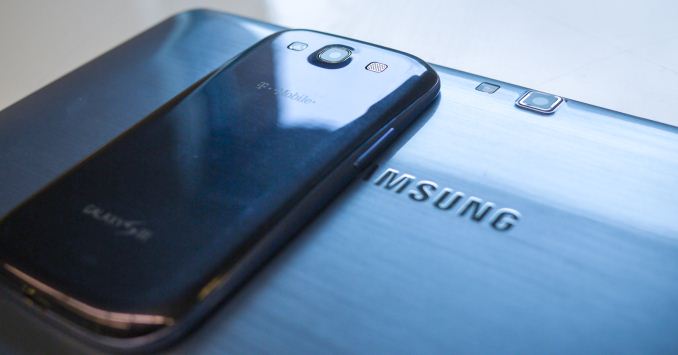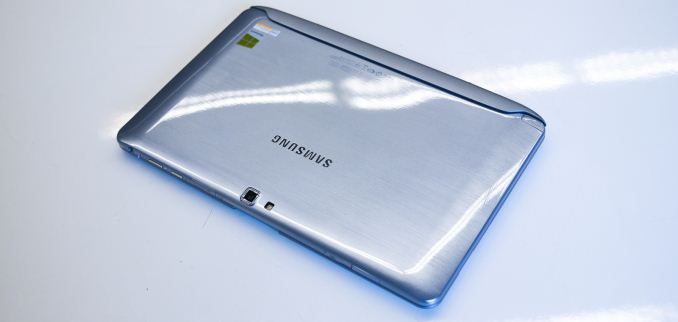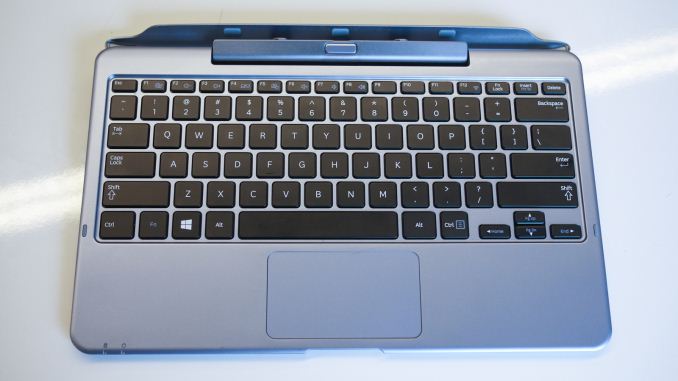Samsung ATIV Smart PC: Revisiting Clover Trail Convertibles
by Vivek Gowri on March 18, 2013 12:00 AM ESTSamsung ATIV Smart PC: Design
The ATIV Smart PC is unmistakably a Samsung design, for better or for worse. The front face is dominated by the display, along with details like the chrome-ringed Windows button, speakers placed on the right and left edges in similar fashion to the Galaxy Tab and Nexus 10, and the webcam and Samsung logo centered above the display. The bezel is uniformly three-quarters of an inch thick all the way around the screen, which allows for comfortable handling of the device without adding too much bulk to the footprint. The body is entirely glossy plastic, with contours similar to the rest of Samsung’s recent mobile industrial design language. The brushed plastic aesthetic in particular will be very familiar to anyone who has handled a pebble blue Galaxy S III or Galaxy Note II in recent times. This isn’t as dark a blue, but they’re clearly related products.
The ATIV Smart PC is kind of chunky though, with a width of 12” and a weight of 1.65lbs. It’s not that thin, either, though it does feel thicker than 9.9mm. It’s too big for ideal one handed use, and the dimensions of 10.1” slates (10.5” wide, roughly 1.25lbs) tend to be much better suited for that ergonomically. The problem though, with this slate in particular, is that it feels both bulky and not that well built. The plastic body offers pretty poor in hand feel, with a disconcerting amount of flex exhibited in normal day-to-day handling.
Samsung’s build quality on their plastic products has never thrilled me, particularly the original Galaxy S and Galaxy S III. They clearly know how to design a good looking computer, with their Series 7 and Series 9 notebooks and all-in-ones featuring attractive and well built aluminum bodies. The ATIV doesn’t even cut it from a plastic standpoint, with noticeable seams between the various injection molded plastic pieces that comprise the chassis. Next to the VivoTab, the Samsung feels bloated—the aluminum body of the ASUS is far higher quality and the thinner chassis is much better ergonomically. And compared to tablet design benchmarks like Surface and the iPad, it’s not even on the same planet.
Button and port placement is a bit haphazard, with microHDMI and volume controls on the right side, a USB port, 3.5mm combo jack, microSD card, and microSIM slot located on the top of the device, along with two chrome buttons (power and rotation lock) that are easy to confuse. One, the idea of a SIM slot on a device that doesn’t have a cellular radio is downright baffling. Two, all the ports have flaps. Three ports, a dummy SIM slot, and four flaps. It’s unclean, fiddly, and an industrial design faux pas in this day and age. I’m not necessarily the biggest fan of the top-mounted USB port, but at least it’s better than the ASUS VivoTab’s easy-to-lose and hard-to-replace dongle. Other miscellaneous design details: the raised chrome detailing around the webcam is very Galaxy S III-esque, the Wacom stylus on the side can be difficult to remove from the silo at times, and the Windows and Intel logo stickers on the back are the height of uncool.
The keyboard dock is a definite bright spot. When you add it to the slate, the total size goes up to 3.1 pounds and 0.85” thick. It’s made of a matte plastic that feels better and more solid than the tablet, with a spacious and comfortable chiclet-style keyboard along with a buttonless ELAN multitouch trackpad. The dock also has two USB ports, one on either side, and both are covered by flaps (tragic).
The tablet connects to the dock with two clips and a 13 pin trapezoidal connector, and disengages with a button located at the center of the hinge. It’s a bit buggy at times—something about the electrical connection between dock and tablet occasionally goes on the fritz, resulting in a series of disconnections and reconnections usually fixed by adjusting the hinge angle or removing and reinserting the tablet. Unlike ASUS keyboard docks, the Samsung docks don’t include a battery. This results in a thinner, lighter dock, but having a second battery in the dock would probably be worth the extra bulk, for reasons I’ll discuss in the battery life section.
The ATIV Smart PC design and hardware is adequate, but honestly, based on the Windows tablets I’ve been dealing with in the last six months, I’d put Samsung behind Microsoft, ASUS, Vizio, and even Acer when it comes to Windows 8 tablet hardware design. Compared to the level of industrial design and quality we’ve come to expect from the current crop of tablets and ultrabooks, Samsung has really missed an opportunity to even be competitive here.














59 Comments
View All Comments
beginner99 - Tuesday, March 19, 2013 - link
Suspected that but makes the whole benchmark even more flawed it is in the first place. It doesn't even mention the browser used, at least not easily visible. I assume it was IE then considering the crappy performance.Kidster3001 - Tuesday, March 19, 2013 - link
Kraken ( and Sunspider ) are not CPU or even system benchmarks. They are Browser benchmarks only. Clovertrail and Clovertrial+ scale perfectly with frequency as compared to Medfield when they use the same browser.kyuu - Monday, March 18, 2013 - link
Hope a review of the Vizio Tablet PC with the AMD C-60 is incoming soon!kyuu - Monday, March 18, 2013 - link
Er, Z-60.nikon133 - Monday, March 18, 2013 - link
What about Lenovo ThinkPad Tablet 2? I think proper docking station option (with LAN, external screen and a few USB ports) makes it really interesting among Clover Trail tablets, but it is not being mentioned here at all. Is it available in US?hughtwg - Tuesday, March 19, 2013 - link
Yes, it's available in the US. Mine is on Ebay at the moment.I think docking the tablet directly to a keyboard like the Ativ, or Envy X2 is much more practical than a dock like that provided by the TPT2 since the keboards have essentially the same ports as the non mobile dock for the TPT2. I bought the TPT2 for the stylus support but found it rather disappointing due to a combination Windows 8 and Lenovo issues.
sprockkets - Monday, March 18, 2013 - link
Still no Nexus 10 review...A.J. - Tuesday, March 19, 2013 - link
Pls try using the same Google Chrome/MS IE10 in Octane or Kraken javascript benchmark test!It's totally ridiculous to have the javascript benchmark score with different browsers. Am I looking at a browser test?
with Chrome25:
I got 2580 on Octane bench,
about ~900ms in Sunspider,
and ~12000ms in Mozilla Kraken.
Intel Clover Trail Atom is way better than old cortexA9! Even close to cortexA15 in some cases.
And with the remarkable 1.7W TDP, it totally smashes the A15 in efficiency!
Curious to see 22nm BayTrail quad-core Atom vs Tegra4.
paulbram - Tuesday, March 19, 2013 - link
Although in general I agree it is not fair to compare different browsers, I think you also need to remember that Chrome on a Windows 8 CT chip is really not NEARLY as good as IE10 is. In fact, I've been incredibly impressed with IE10 perf on mine. So, sure you could run Chrome if you want to see poor benchmark results, but why not give the machine the best chance at success?Kidster3001 - Tuesday, March 19, 2013 - link
Javascript benchmarks are "Browser" benchmarks, not CPU benchmarks. They are completely dependent on the javascript engine used in the browser.